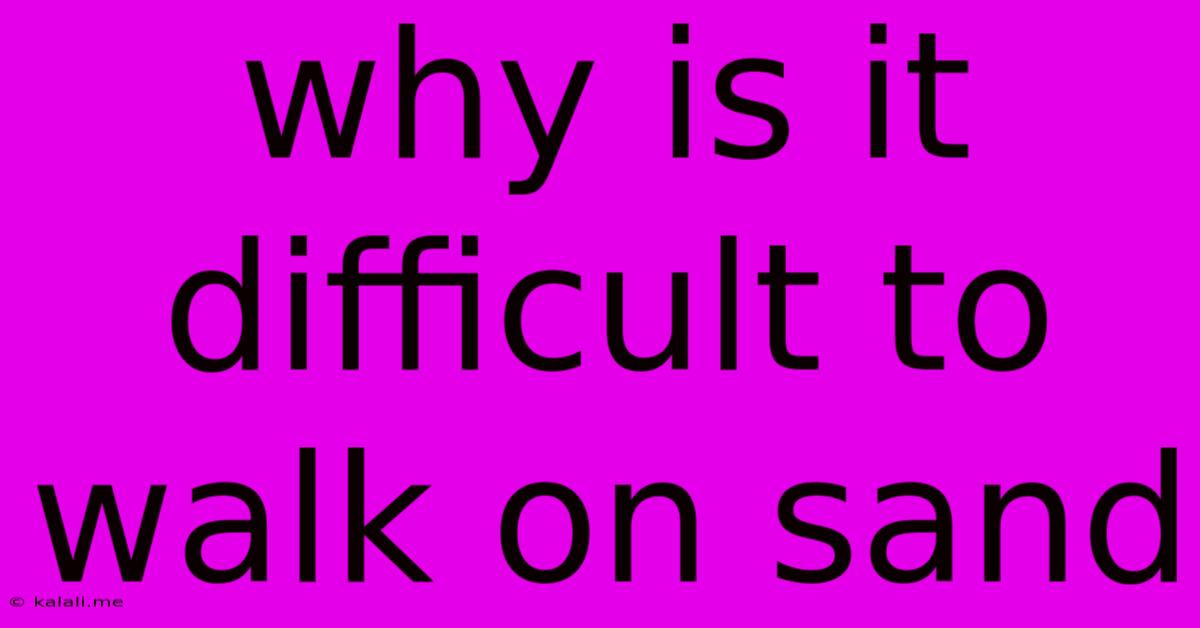Why Is It Difficult To Walk On Sand
Kalali
Jun 06, 2025 · 3 min read

Table of Contents
Why Is It So Difficult to Walk on Sand? The Physics of a Beach Stroll
Walking on sand is a deceptively challenging activity. While it might seem like a simple task, the physics behind why it's harder than walking on solid ground are surprisingly complex and fascinating. This article delves into the reasons why sinking into soft sand makes beachcombing a workout, covering everything from grain size and moisture to the principles of pressure and buoyancy.
Understanding the Subsurface: Unlike solid surfaces like concrete or pavement, sand lacks the rigid structure necessary for stable support. Each grain of sand is essentially an independent particle, creating a granular material with unique properties. This lack of cohesion is the primary reason walking on sand requires more effort.
The Role of Grain Size and Packing
The size and shape of the sand grains significantly impact how easily they compact and support weight. Fine sand, with its smaller particles, tends to pack more tightly, offering slightly better support than coarse sand. However, even tightly packed fine sand lacks the cohesive strength of a solid material. The irregular shapes of sand grains further complicate the matter, preventing them from interlocking efficiently.
The Impact of Moisture Content
The moisture content of the sand is another crucial factor. Dry sand is notoriously difficult to walk on because the grains are not bound together by any cohesive force. They shift and slide underfoot, offering minimal resistance. Wet sand, on the other hand, exhibits some cohesion due to surface tension between the water molecules and the sand grains. This makes walking on wet sand easier, but it's still more challenging than walking on solid ground. However, excessively wet sand can become saturated, resulting in a quicksand-like consistency that is even more difficult to navigate.
Pressure, Buoyancy, and Sinkage
When you walk on sand, your weight is distributed over the area of your feet. The pressure exerted on the sand causes the grains to rearrange and compact. However, the loose structure of the sand means that this compaction is not as effective as on a solid surface. Your foot sinks into the sand until the upward pressure from the compacted sand equals your weight. This phenomenon is partially influenced by buoyancy, as the sand grains partially displace the air or water surrounding them, reducing the effective weight you are applying.
The Energy Expenditure Enigma
The difficulty of walking on sand translates directly to increased energy expenditure. The constant effort of keeping your feet from sinking and maintaining balance requires more muscular work than walking on a firm surface. This is why a walk on the beach often feels more strenuous than a comparable walk on pavement.
Practical Implications and Adaptations
Understanding the physics behind walking on sand allows us to better appreciate the challenges involved and to employ strategies to improve our locomotion across sandy terrains. Larger footprints, such as those made with wide beach shoes or by shuffling your feet, distribute your weight more effectively, reducing sinking and improving stability.
In conclusion, walking on sand is difficult due to the combination of factors affecting the granular material. Grain size and shape, moisture content, pressure distribution, and buoyancy all interplay to create a walking surface that requires significantly more energy and effort compared to solid ground. Appreciating these physical principles enhances our understanding of a seemingly simple yet complex activity.
Latest Posts
Latest Posts
-
The Impact The Character Has Vs Appearance
Jun 07, 2025
-
How To Get Rid Of Rats In My Yard
Jun 07, 2025
-
Can I Back Feed Electricity From Generator
Jun 07, 2025
-
Is Gluten Free Kosher For Passover
Jun 07, 2025
-
How To Prevent Dogs From Digging In Yard
Jun 07, 2025
Related Post
Thank you for visiting our website which covers about Why Is It Difficult To Walk On Sand . We hope the information provided has been useful to you. Feel free to contact us if you have any questions or need further assistance. See you next time and don't miss to bookmark.